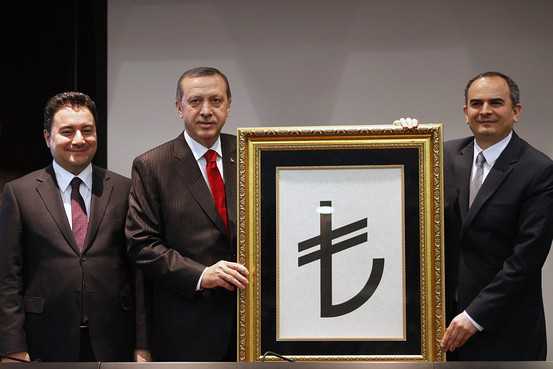
Turkey’s Prime Minister Recep Tayyip Erdogan, flanked by Deputy Prime Minister Ali Babacan (left) and Central Bank Governor Erdem Basci (right) poses with the new symbol of Turkish Lira in Ankara
ISTANBUL — For decades, “safe harbor” wasn’t a term readily associated with the Turkish lira.
In the latter part of the twentieth century, the currency was infamous instead as a haven for volatility and hyper-inflation. Shunned by investors and exchanged hastily by Turkish consumers, the lira’s lowest-denomination note was 100,000.
Following a 2001 banking crisis, a painful structural reform program helped pull the lira back to earth, prompting a shift in market perceptions. Turkey’s government in 2005 took the risky step of stripping six zeros from the currency, but the economy continued to expand and later emerged relatively unscathed from the financial crisis.
“Brand Lira” began to be seen an economic asset, rather than a liability.
In a bid to capitalize on the lira’s growing prominence in international markets, Turkey on Thursday introduced a new symbol for the national currency.
The symbol–a double-crossed, T-shaped anchor–is intended to mean “safe harbor” says Turkey’s Prime Minister Recep Tayyip Erdogan. The upward-facing crosses symbolize Turkey’s growing economic clout, he added.
The launch also reflects Turkey’s ambitious aspirations to become one of the world’s top economies. Turkey’s government has targeted becoming one of the world’s top 10 economies from its current ranking of 16th by 2023, the 100th anniversary of the founding of the Turkish Republic. The central bank has vowed to promote the lira as a reserve currency, recently signing local currency swap deals with Pakistan and China.
Not everyone welcomed the new symbol. The main opposition Republican People’s Party said the icon had been made in the initials of the prime minister, raising questions over the bank’s independence from government.
“The final point of the Central Bank’s independence has been to make Tayyip Erdogan’s initials the symbol of our currency,” said the party’s economics and fiscal policy deputy chairman, Faik Oztrak, in a statement.
Speculation over the bank’s independence has risen since April, when Erdem Basci, a childhood friend of Turkish economic czar and Deputy Prime Minister Ali Babacan, was named bank governor.
Speak to Turkish traders and they’ll confirm that the Turkish lira has made a quantum leap in terms of market credibility.
“In a way the symbol symbolizes a turning point for the Turkish lira… Policy was reformed and made the Turkish lira a much more credible currency. That’s because Turkey is a more credible economy… short-term risks remain but longer-term Turkish lira stability is here to stay,” says Guldem Atabay, chief Turkey economist at UniCredit.
Gone, it seems, are the bad old days of the 1990s when Turks would immediately exchange their liras for dollars or Duetsche Marks before triple-digit inflation rendered them worthless.
Still, risks do remain.
Despite a growth rate in 2011 that economists expect to top 8%, the lira fell more against the dollar than any other currency last year, dropping 18% as investors balked at Turkey’s gaping current-account deficit and unorthodox monetary policy. Turkey’s structural imbalances haven’t gone away, with fast-rising oil prices posing a new danger for an economy heavily dependent on energy imports.
But so far this year Turkish assets have been among the big winners, pushing the lira as much as 8% higher against the dollar–one of the fastest rises of any emerging-market currency.
Prime Minister Erdogan on Thursday hailed the new lira symbol as representative of Turkey’s swelling economic prestige.
“People used to mock us when we had many zeros in our currency, and it made trading transactions very difficult. Now our citizen is proud of our currency, his passport and flag. Now is the time that our currency will become more known across the world.”
via Turkey Unveils ‘Safe Harbor’ Lira Symbol – Emerging Europe Real Time – WSJ.

